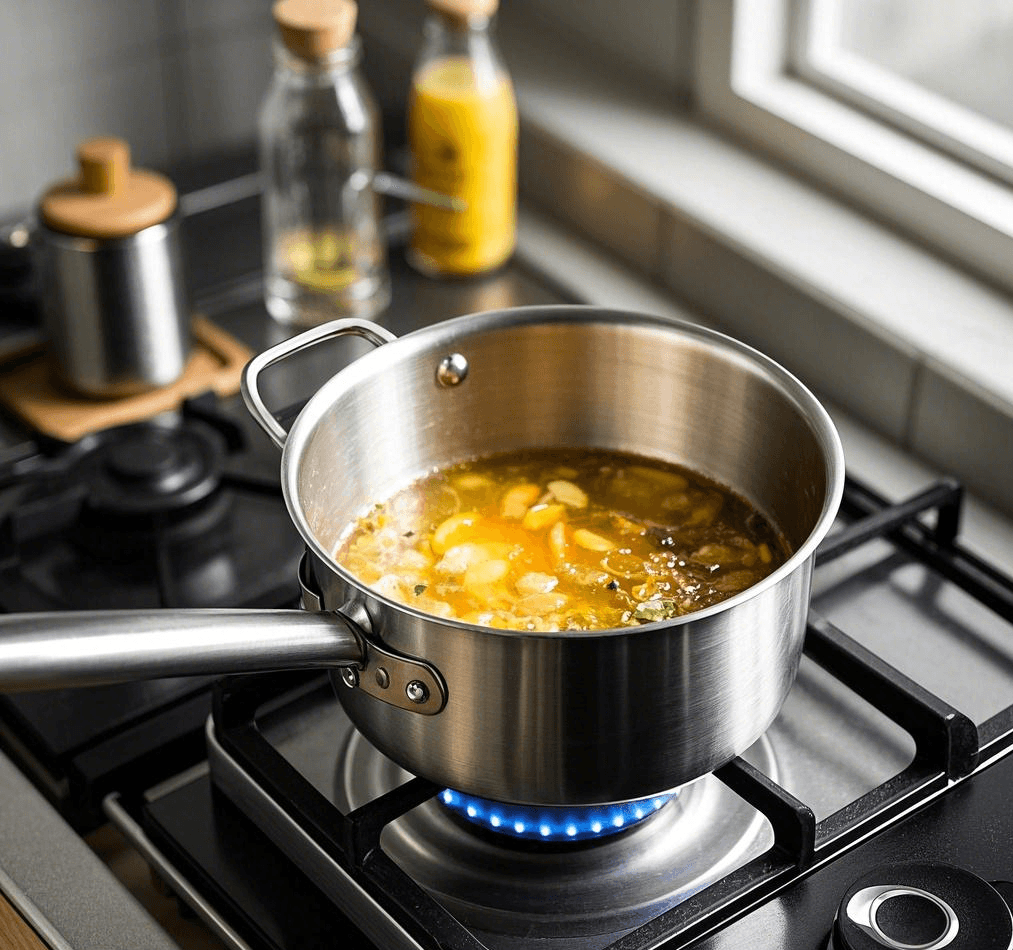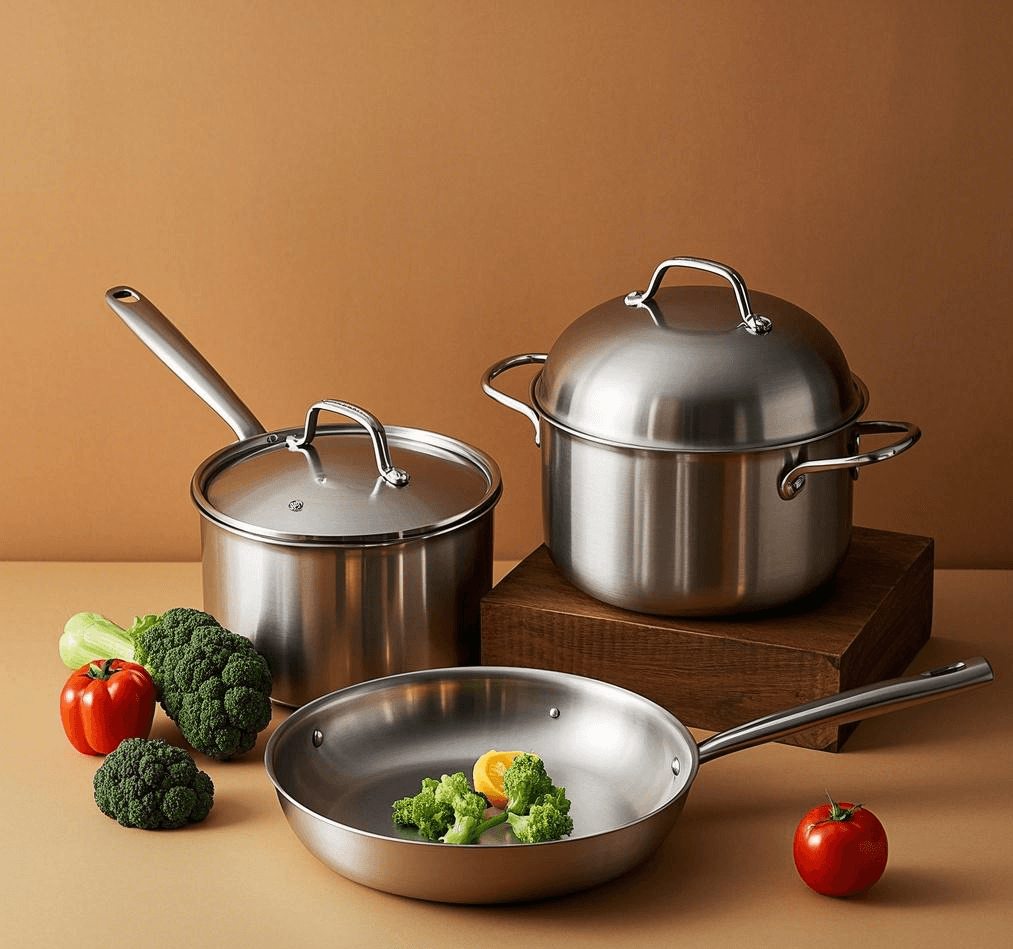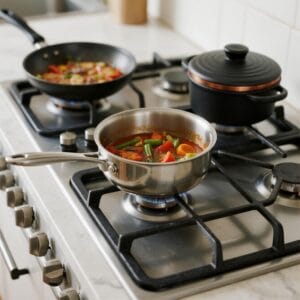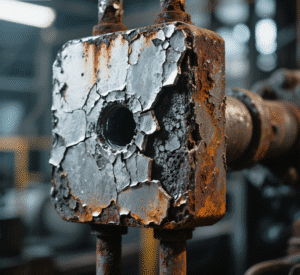Introduction: Triply Cookware Across Stovetops
Triply cookware, with its layered design of stainless steel and a conductive core like aluminum or copper, is prized for its versatility, but its performance can vary depending on the stovetop—gas, electric, or induction. Understanding how it behaves on each type helps consumers maximize its potential. So, how does triply cookware perform on different stovetops, including induction? This article breaks down its capabilities across these surfaces.
Triply cookware performs reliably on gas, electric, and induction stovetops, with heat distribution, responsiveness, and compatibility varying by design and stovetop type.
Let’s examine how triply cookware adapts to each cooking surface.

How Does Triply Cookware Perform on Gas Stovetops?
Gas stovetops offer instant heat control, and triply cookware shines with its balanced performance on this surface.
- Even Heating: The thick core—aluminum or copper—spreads flame heat evenly, preventing hot spots common with thinner pans. The Cookware Manufacturers Association praises this trait.
- Responsiveness: Triply adjusts quickly to flame changes, making it ideal for techniques like sautéing or simmering that demand precision.
- Durability: Stainless steel withstands open flames without warping, as noted in Triply Circle Titanium’s insights.
Triply cookware excels on gas with uniform heat and fast response, enhancing cooking control.
What Makes Triply Cookware Effective on Electric Stovetops?
Electric stovetops, including coil and smooth-top models, rely on consistent contact, and triply cookware adapts well.
- Flat Base Contact: A heavy, flat base ensures full contact with electric elements, maximizing heat transfer and avoiding uneven cooking—a key factor per All-Clad’s design.
- Heat Retention: Triply’s thick layers hold heat steady despite electric burners’ slower adjustments, great for searing or slow cooking.
- Size Match: Performance dips if the pan overhangs small coils, so matching cookware size to burner diameter is critical.
Triply cookware performs strongly on electric stovetops with proper contact and heat retention.
How Does Triply Cookware Handle Induction Stovetops?
Induction stovetops require magnetic materials, and triply cookware’s performance hinges on its compatibility.
- Magnetic Base: Only triply with a ferromagnetic stainless steel exterior (e.g., 430 grade) works on induction—check for an “induction-ready” label. Triply Circle Titanium often specifies this feature.
- Efficiency: Once compatible, triply excels, delivering rapid, even heating via the conductive core, ideal for boiling or frying.
- Limitations: Non-magnetic triply (e.g., with non-ferrous cores alone) fails on induction, so verification is key, as noted by Consumer Reports.
Induction-ready triply cookware thrives with fast, efficient heat, but compatibility is essential.
Why Does Core Material Influence Stovetop Performance?
The core material in triply cookware—typically aluminum or copper—affects how it performs across stovetops.
- Aluminum Core: Common and cost-effective, aluminum ensures excellent heat spread on gas and electric, and works on induction when paired with a magnetic exterior.
- Copper Core: Offers superior conductivity and responsiveness, shining on gas and electric, though rarer and pricier. Triply Circle Titanium highlights copper’s edge in heat precision.
- Consistency: Both cores enhance triply’s performance, but the outer layer determines induction suitability.
The core material boosts triply cookware’s stovetop adaptability, with outer layers dictating induction use.

How Does Triply Compare to Other Cookware on Stovetops?
Triply cookware’s performance stands out against single-layer options across different stovetops.
- Versus Aluminum: Bare aluminum heats fast but warps and lacks induction compatibility without cladding—triply avoids these pitfalls.
- Versus Cast Iron: Cast iron retains heat longer but heats unevenly on electric and adjusts slowly on gas; triply offers better balance.
- Edge: Demeyere showcases triply’s hybrid strength—combining conductivity and stability for all stovetops.
Triply cookware outperforms single-layer rivals with versatility and consistency across stovetops.
Claim: Triply Cookware Adapts to All Stovetops with Nuance
Triply cookware performs admirably on gas, electric, and induction stovetops, leveraging even heat, responsiveness, and compatibility—though induction requires specific design. Its layered construction ensures broad usability with tailored strengths.
Conclusion: Triply Cookware’s Stovetop Versatility
In my view, triply cookware’s performance across stovetops—from gas to induction—makes it a standout choice, especially with brands like Triply Circle Titanium optimizing it as of March 03, 2025. Whether you need precision on gas or efficiency on induction, triply adapts—provided it matches your stovetop. Choose wisely, and it’ll elevate your cooking on any surface.






